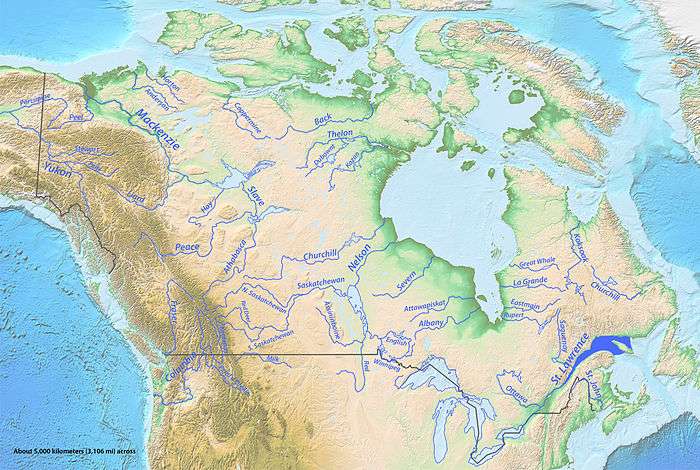Dubawnt Lake
| Dubawnt Lake | |
|---|---|
 Dubawnt Lake | |
| Location | Kivalliq Region, Nunavut |
| Coordinates | 63°4′0″N 101°42′0″W / 63.06667°N 101.70000°WCoordinates: 63°4′0″N 101°42′0″W / 63.06667°N 101.70000°W |
| Primary inflows | Dubawnt River |
| Primary outflows | Dubawnt River |
| Basin countries | Canada |
| Surface area | 3,833 km2 (1,480 sq mi) |
| Surface elevation | 236 m (774 ft) |
| Islands | Snow Island |
| Settlements | uninhabited |
| References | [1][2] |
Dubawnt Lake is a lake in Kivalliq Region, Nunavut, Canada. It is 3,630 km2 (1,400 sq mi) in size and has several islands.[2] It is about 200 miles north of the point where Manitoba, Saskatchewan and Nunavut come together, about 300 miles west of Hudson Bay and about 250 miles south of the arctic circle. To the northwest is the Thelon Wildlife Sanctuary. Its main inlet and outlet is the north-flowing Dubawnt River which joins the Thelon River at Beverly Lake (Nunavut). The Thelon flows east to Hudson Bay at Chesterfield Inlet. It is on the line of contact between the Sayisi Dene band of Eastern Caribou-Eater Chipewyan people and the Harvaqtuurmiut and Ihalmiut bands of Caribou Inuit. The first European to reach the lake was Samuel Hearne in 1770, but it remained largely unknown to outsiders until it was explored by Joseph Tyrrell in 1893. There are no permanent settlements but there are fly-in fish camps where large lake trout can be caught during the 2-month ice-free season.
 |
Dubawnt River
The Dubawnt River is 543 miles long and begins from a tributary of Wholdaia Lake northwest of the point where Manitoba, Saskatchewan and Nunavut join. There is a portage from the Flett Lake tributary of Wholdaia Lake to Selwyn Lake which drains southwest to Lake Athabasca. In 1893 Joseph Tyrrell canoed from Lake Athabasca down the Dubawnt to Chesterfield Inlet. Lakes along the river are Wholdaia, Barlow, Cary, Markham, Nicholson, Dubawnt, (Dubawnt Gorge), Grant, Wharton and Beverly. East of the Dubawnt, the Kazan River also flows north to join the Thelon.
Ethnography
The area of the lake was once home to Ihalmiut, a Caribou Inuit group.[3]
Wildlife
Dubawnt Lake is home to many animals, including foxes, wolves and many birds of prey.
See also
References
- ↑ "Principal lakes, elevation and area, by province and territory". Statistics Canada. 2005-02-02. Retrieved 2015-03-11.
- 1 2 "World Lake Database (Dubawnt Lake)". Retrieved 2015-01-09.
- ↑ Mowat, Farley (2006). No Man's River. Carroll & Graf Publishers. p. 62. ISBN 0-7867-1692-4. Retrieved 2007-12-24.